Soil and Water Management TIMPs
- The management of soil and water resources is one of the basic principles for development.
- Water and land degradation leads to increased use of inputs and greater costs to farmers.
- It helps protect natural resources and watersheds, improves water quality, and makes soil healthier. It also creates economic opportunity.
- There are several technologies and practices that can help in soil and water management as detailed below:
- Zai pits are holes dug to collect and retain runoff to allow water to go into the soil.
- The dug pits collect and concentrate water to the plant.
- They are usually fertilized with plant remains or compost.
- They are used to cultivate crops like sorghum, maize, millet, cowpeas, sweet potatoes, groundnuts and bananas.
- Two handfuls of organic material (animal dung or crop residues) is placed at the bottom of the pit.
Where Suitable
- Arid to semi-arid areas (annual rainfall of 200- 750 mm).
- Gentle slopes (less than 5 %).
- Soils like silt and clay, where digging is difficult.
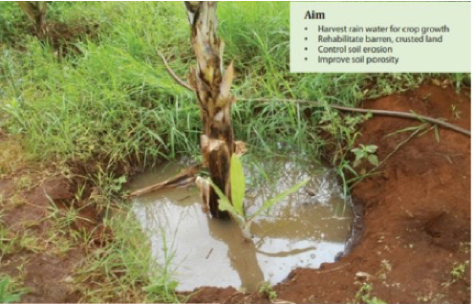
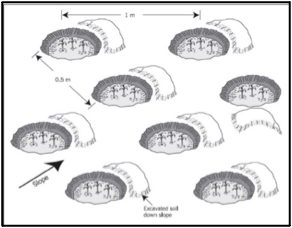
Source: PRESSA 2009
How to Construct a Zai Pit
- Zai pits are 5-15 cm deep, 15-50 cm wide and 80-100 cm apart. In dry areas the size of planting pits can be enlarged.
- Place compost or manure in the pits before planting to improve soil fertility.
Benefits of Zai Pits
- Produces higher grain yields, particularly on highly degraded sandy soils.
- Good potential to both increase the livelihood of the rural population in the drylands.
- Reduces land ruin.
- Rehabilitation of crusted soils and gentle clay slopes with limited infiltration and difficult tillage.
- Can help restore degraded soils, soil erosion, and soil moisture stress.
- Reduce the risk of water stress in a region of low and erratic rainfall.
- They improve soil fertility and hence agricultural productivity of several crops.
Constraints of Zai Pit
Needs a lot of labor when establishing, especially digging and fertilizing. It is more realistic when done groups of farmers instead of individuals.
- These are stone or earthen walls built across a slope to prevent hold water.
- The goal is to concentrate moisture into the ridge and furrow area where the crops are planted.
- Plants with higher water requirements, such as peas or beans, can be planted on the higher side of the furrow whereas cereal crops requiring less water, such as sorghum or millet, can be planted on the ridges.
- One can plant nitrogen-fixing trees/shrubs, grasses, fruit trees or other crops in rows along the contour.
Where Suitable
- Areas with relatively low annual rainfall (500-800 mm).
- Light textured soils of 1.5 to 2 m depth.
- Gentle to moderate slopes (0.5-3%).
- Areas with no gullies or rills.
- Large land areas (contour hedgerows cover at least

How to Make a Contour Bund and Hedgerows
- Dig soil up-slope of the bund to a depth of 50 cm.
- Make furrows parallel to the contours.
- Contour bunds should drain in one direction and can be manually or machine constructed.
- The length of a bund across a slope should be between 400 to 500 m.
- The height of a bund should be at least 25 cm, with spacing of 1-2 m. In arid areas, the distance between bunds can be increased to 5-10 m.
- Hedgerows grown to stabilize bunds should be spaced at 4 to 8 m across the slope.
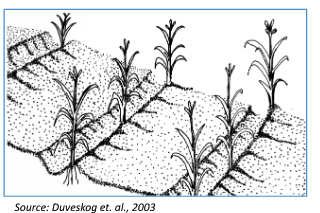
Benefits
- Reduced water runoff hence low soil erosion.
- Reduced water runoff hence more water for crop growth.
- Spreads rainfall and runoff evenly over a field.
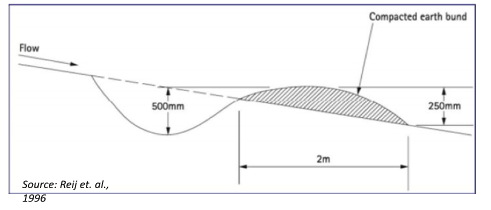
Bench terraces consist of a series of beds which are more or less level running across a slope at vertical intervals, supported by steep banks or risers (walls or bunds). The flat beds created by bench terraces enable the cultivation of crops on medium to steep slopes.
Where Suitable
- Semi-arid to humid regions of rainfall, 700 mm or more.
- Medium to steep slopes (12- 47%) (Not recommended for slopes less than 12%).
- Soil depth of greater than 50 cm.
- Areas with no gullies, nor stones.
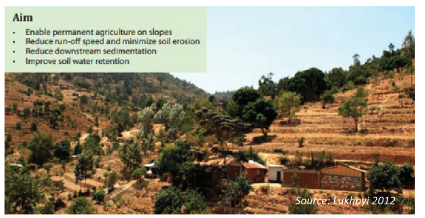
How to Make Bench Terraces
- Terraces draining in one direction should be at least 100m or more. The length can be slightly increased in arid and semi-arid regions.
- Optimum width of terrace benches ranges from 2.5 to 5 m for manually constructed ones and from 3.5 to 8 m for machine-built ones.
- Terraces should drain runoff along the horizontal gradient of the slope, either in outward or reverse direction.
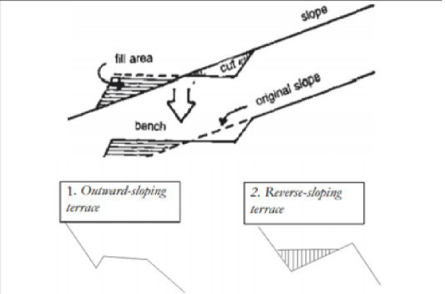
Method of farming that conserves, improves and uses natural resources for production.
How to Practice Conservation Agriculture?
To practice conservation agriculture a farmer will need to do these 3 things:
- Minimum soil disturbance.
- Crop diversification.
- Permanent soil cover.
Minimum Soil Disturbance
- The farmer tills the soil as little as possible or disturbs the soils as little as possible.
- The farmer should dig only where the seed, fertilizer and manure are to be placed. This is done by preparing permanent planting basins based on the crop recommended spacing
- The planting basins/hills and rip lines/rows are permanent as the farmer returns to these in subsequent seasons.
- To avoid weeds competing with crops, the farmer needs to use recommended pre - or post-emergence herbicide.
- Planting can be done by special seeders.
- Chemical weed control is an important option in minimum tillage practice.
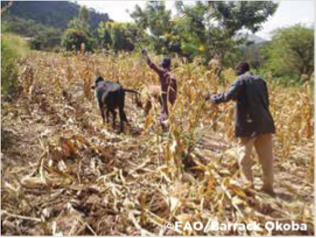
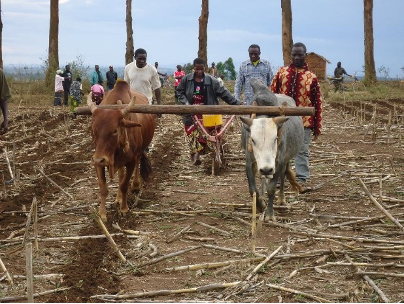
Photo: Minimum tillage Source: ACT
Benefits of Minimum Tillage Practice
- Improves water penetration in the farm.
- Improves soil fertility.
- Saves time, energy, and money because less land is tilled.
- Reduces soil degradation caused by wind and water erosion.
- Reduces soil compaction because the crop plant roots are left undisturbed.
Permanent Soil Cover
- The farmer can use crop residues to make permanent soil cover on their farms.
- If a farmer does not have crop residues, they can use cover crops to attain maximum soil cover.
- The cover crops include cowpeas, velvet beans, soya beans, common beans etc.
Benefits of Permanent Soil Cover
- Reduces soil erosion.
- Helps water go deep into the soil which is good for crop production.
- Reduces water evaporation and so conserves moisture for the crop.
- Controls growth of weeds.
- Improves the soil fertility.
- Regulates soil temperature.
Benefits of Conservation Agriculture
- Resource saving: Reduced ploughing saves farmers energy, labor and time.
- Time savings: Time savings allow farmers to plant earlier, perhaps by weeks.
- Pest and diseases control: Crop rotation helps break crop disease cycles.
- Reduces crop failure risks: Planting different crops assures a farmer some harvest.
- Improved soil water management – good soil moisture for crop growth
- Reduction in labor use.
- Reduction in the cost of production
Crop Diversification
The farmer will need to grow several crops on his land. This is done through embracing crop rotation or intercropping.
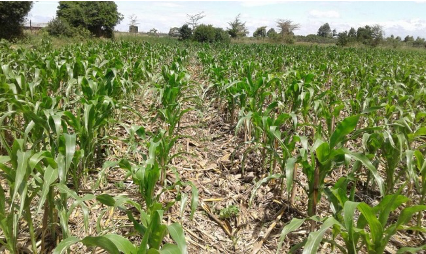
Photo: Permanent soil cover Source: ACT
5.Crop Rotation Management Practice
- Plant different crops in a particular order over several seasons/years in the same farm unit.
- The length of rotation time between different plants will depend on the rotated crops, farmer’s economic circumstances and locally adopted farming systems.
- Include a rotation with legumes crops like beans, groundnuts etc.
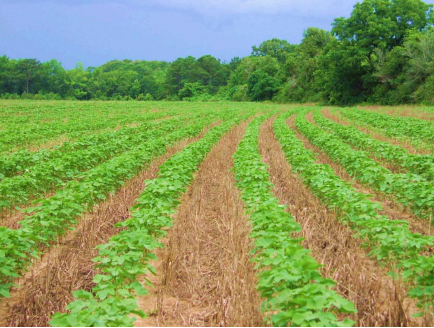
Photo: Crop rotation Source: KALRO Flicker
Benefits of Crop Rotation
- Improves soil fertility through legume crops.
- Breaks the cycle of dominant pests and diseases.
- Provides crop residues.
- Plant two or more crops in the same farm unit same season/year.
- This is good where land for cultivation is limited due to high human population.
- For example, one can inter-crop maize with field beans or sorghum with cowpea.
6.Intercropping Management Practice
- Plant two or more crops in the same farm unit same season/year.
- This is good where land for cultivation is limited due to high human population.
For example, one can inter-crop maize with field beans or sorghum with cowpea.

Photo: Crop intercropping Source: KALRO Flicker
Benefits of Intercropping
- Greater yield/increased yield and income.
- Insurance against crop damage because they have diverse.
- The plants share soil nutrients e.g., legumes fix nitrogen for the other plants.
- Helps in weed control, also reduces incidences of insects and disease.
- Constructed by digging soil and throwing it up-slope to make an embankment.
- The embankment forms a runoff barrier and the trench (ditch) is used to retain or collect runoff.
- Planting of fodder grasses on the embankments assists in stabilizing them.
- Crops, such as bananas, pawpaw, citrus and guava, are grown in the ditches.
Where Suitable
- Low annual rainfall areas (less than 700 mm).
- Moderate slopes (less than 20%).
- Deep soils (more than 60 cm).
- Hilly areas that are subject to widespread erosion.
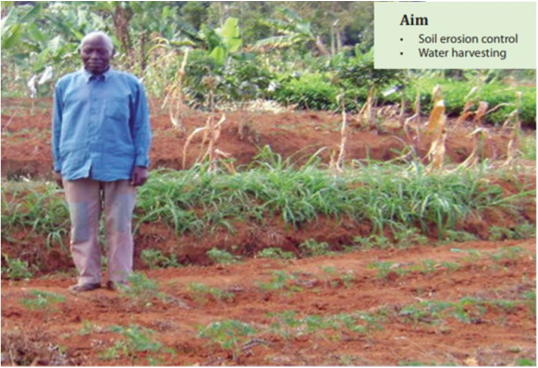
Photo: Fanya juu terraces Source: Mokua 2007
How to Make Fanya Juu Terraces
- Make a of 60 cm wide by 60 cm deep, and the bund 50 cm high by 150 cm across. In arid regions the trenches can be enlarged to 150 cm deep and 100 cm wide.
- Distance between bunds can be from 5 m on steep slopes to 20 m on gentle slopes.
- One can build stone terrace walls to reinforce the bunds on very steep slopes. This allows surplus water to pass between the stones without damaging the terrace.
- Excess water can be drained from the trenches using cut-off drains.
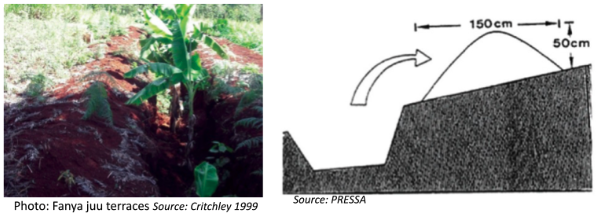
- They are dense strips of grass planted up to a meter wide, along a contour. With time, silt builds up above the strip and benches are formed.
- They can be planted along ditches to stabilize them, or on the rises of bench terraces to prevent erosion.
- They are a popular and easy way to terrace land, especially in areas with relatively good rainfall.

Photo: Grass strips Source: Obwocha 2009
Where Suitable
- Fairly gentle slopes (0 - 6%).
- Areas where grass is needed for fodder.
- High rainfall areas.
How to Make Grass Strips
- Spacing between grass strips depends on the slope of the land. It can be 20-30 m on gentle slopes and 10-15m on steep land
- Can be planted along ditches to stabilize them, or on the rises of bench terraces to prevent erosion
- Cut/trim the grass regularly, to prevent shading and spreading to cropped areas.
- Some of the good grass species include Vetiver, Napier, Guinea and Guatemala, but depends on what is locally available.
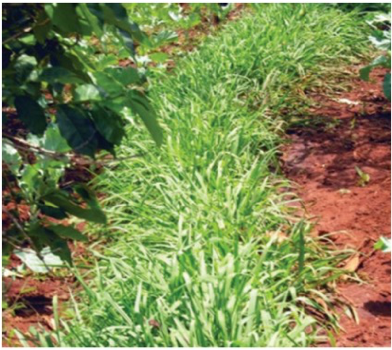
Source: PRESSA 2009
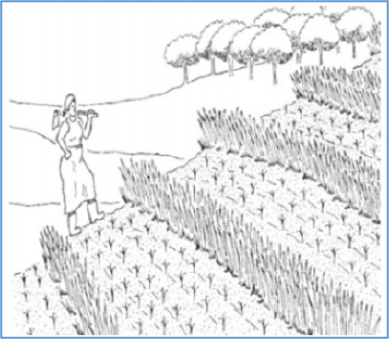
Source: PRESSA 2009
Stone lines are stones placed along contour lines to slow down runoff. With time, the soil builds up on the upslope side of the stone line and a natural terrace is formed.
Where Suitable
- Gentle to moderate slopes (less than 10%).
- Low annual rainfall areas (200 - 750 mm).
- Stony areas.
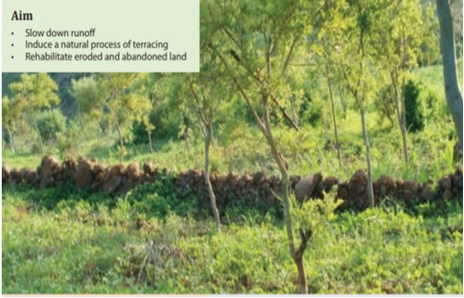
Photo: Stone lines Source: Obwocha 2009
How to Make Stone Lines
- Stone lines are 35-40 cm wide and approximately 25 cm high.
- Construction includes a shallow foundation trench of 5-15 cm made along the natural contour with larger stones on the downslope side of the trench and smaller stones are used to build the rest of the bund.
- The stone lines can be reinforced with earth, or crop residues.
- Tone lines are spaced 15 - 30 m apart; spacing may be reduced for slopes greater than 10%.
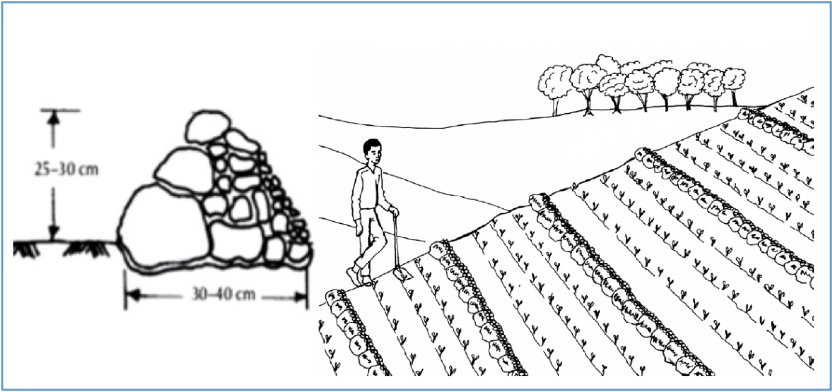
Source: Duveskog 2003; Awulachew 2009
- They are small earthen ridges, 30 cm high, with an upslope furrow which accommodates runoff from a catchment strip between the ridges.
- They increase the water that is available to plants by collecting rainfall in furrows and ridges.
- Planting takes place on either side of the furrows, where the water infiltrates.
- Use specialized planters and cultivators to maintain the permanent ridges.
- Clear the previous crop residue at planting, to allow for the new crop to be planted on the ridges
- Leave crop residue undisturbed on the soil surface until planting time.
- Minimize water loss by placing mulch in the furrows.
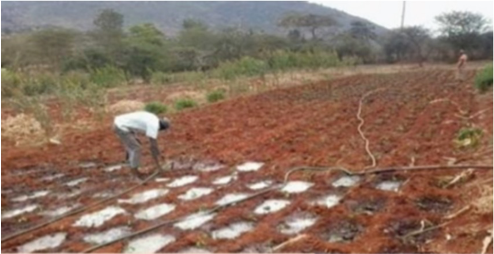
Photo: Tied ridges Source: Itabari 2004
Where Suitable
- Low annual rainfall areas (less than 700 mm).
- Gentle slopes (0-6%).
- Deep soils (more than 60 cm).
How to Make a Tied Ridge
- Construct by hand or using mechanical ridgers.
- Construct along the contours of the field using “A” frames.
- Dig out shallow furrows along the contour lines of the slope and make ridges on the downside of the furrows. Tie them together by slightly lower ridges made at regular intervals along the furrows.
- Ridge spacing depends on the spacing between rows of the crop but the height of the ridges is 30cm high.
- Maintenance involves reconstruction of any lines and ridges that might have collapsed.
Advantages of Tied Ridges
- Reduction in herbicide use, hence cost.
- Improved weed control.
- Residues for the previous crops between the ridges makes the ridges warm, which helps in crop germination.
- Better soil moisture.
- Soil compaction in the root zone is reduced.
- Ridge tillage leaves large amounts of crop residue on the soil surface which greatly reduces erosion and runoff.
Disadvantages
- Its labor-intensive.
- The relatively low number of plants per acre discourages farmers, especially in a good year.
- Does not work well on steep slopes.
- Mulching is the covering of soil between crop rows or around trees with materials
- Mulching protects the soil from splash erosion, formation of crust, prevents weed growth, enhances soil structure, and controls soil temperature.
- Common materials used for mulching include cut grass, crop residues, hay, bark, leaves, husks, sea shells, gravel, stone etc.
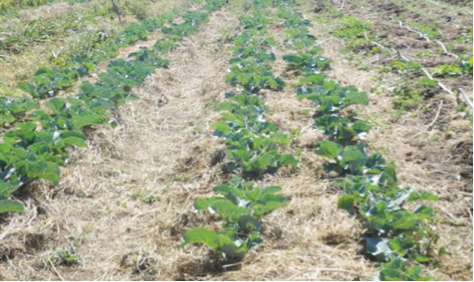
Photo: Crop under mulch Source: Tengnas 1994
Where Suitable
- Drought and weed prone areas.
- Low to medium annual rainfall areas (Mulching is not suitable in wet conditions).
- Soils with good drainage.
How to Mulch your Farm
- Mulch is often spread in strips on seedbeds or around planting holes.
- Large pieces of crop residues should be cut into smaller pieces before application.
- Crop mulches work best if a layer of 2.5 to 10 cm depth is evenly spread.
- Mulch should be placed no closer than 15 cm from the base of a tree.
- Fine mulching material should be spread more shallowly to allow aeration.
- Crop residues, such as maize stalks can be left on the ground after harvesting to act as much.
- The mulch may be covered with a layer of soil to protect it against wind.
Cost
Cost varies depending on the choice of mulch material used.
A roof catchment is a system with gutters in the roof that drain water into a suitable storage system such as a tank or a water pan. It is especially used in roofs made of iron sheets or clay tiles.
Green Manure Cover Crops
- It’s a crop that is grown and then intentionally ploughed under to improve the underlying soil while green or just after flowering.
- Also protect the soil and act as a soil amendment.
- Fast growing, hence accumulates high biomass within a short period of time.
Participatory Range Land Management
- It is a systematic process that involves a series of activities including inventory of existing range resources, identification of the grazing unit, and implementation of range land management plan.
- The approach considers the indigenous knowledge of local resources and integrate it with the conventional range land restoration techniques.
- SUSTAINET EA 2010. Technical Manual for farmers and Field Extension Service Providers: Conservation Agriculture. Sustainable Agriculture Information Initiative, Nairobi.
- https://www.kalro.org/sites/timps/KCSAP%20TIMPs%20-%20NRMAug%202019.pd
- Namirembe, S., Nzyoka J.M. & Gathenya, J.M. 2015. A guide for selecting the right soil and water conservation practices for small holder farming in Africa. ICRAF Technical manual No.24. Nairobi, Kenya: World Agroforestry Centre (ICRAF).
Kenya Agricultural and Livestock Research Organization
P.O. Box 57811-00200, Nairobi, Kenya
Call: 0111010100